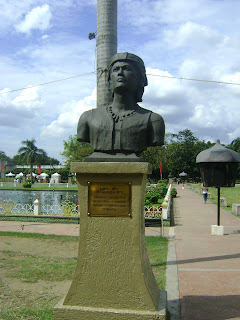Two long columns of Filipino heroes run the length of Rizal Park. Here are a few of them. Click on the image captions for an enlarged view:
 |
| Apolinario Mabini |
Overcoming extreme poverty and a crippling paralysis, he became known as the Brain of the Philippine Revolution. He was one of the chief advisers of President Emilio Aguinaldo and served as a foreign minister and President of the cabinet. He staunchly stood for Philippine independence and was exiled to Guam for his refusal to swear allegiance to the United States.
 |
| Datu Ache |
A Tausug chieftain, who commanded Sultan Bongsu's force of warriors in repelling an armada of 80 ships with 600 Spaniards and 3,000 Christian Filipino allies led by Governor Sebastian Hurtado de Corcuera on January 4, 1638.
 |
| Datu Taupan |
Also known as Panglima Taupan, he was the leader of the Sama Balanguigui of Zamobanga, Basilan and Tonquil islands. He fought for the independence of his people against Spanish incursions and launched raids against Spanish settlements. In 1848, Spanish forces using modern gunboats finally took Balanguigui Islands after a fierce battle. Datu Taupan and his followers were captured and were relocated to Isabela province in Northern Luzon.
 |
| Diego Silang |
Working as a mail courier between Manila and Vigan, Ilocos Sur, he was witness to the excesses of the Spaniards. During the British Invasion of Manila, he urged his provincemates to arm themselves against the British and at the same time demanded the abolition of forced labor and tribute. His actions were misinterpreted as rebellion and he was imprisoned. Upon his release he led a revolt which spread to Pangasinan and Cagayan. He also allied himself with the British to gain diplomatic support. Fearing his growing power, the Spaniards had him treacherously assassinated by his friend Miguel Vicos on May 28, 1763.
 |
| Francisco Dagohoy |
Enraged by the refusal of a Spanish friar to bury his brother, he led a rebellion against Spanish rule which lasted from 1744 to 1829. The rebellion which was also fueled by excesses of the Spanish authorities lasted for more than 80 years, the longest in Philippine history.
 |
| Francisco Maniago |
A leader of the village in Mexico, Pampanga, who led a revolt in protest against forced labor and confiscation of rice by the Spaniards. He blocked the mouths of the rivers of Pampanga to stop commerce with Manila. His rebellion ended with the acceptance of his demands by the Spaniards.
 |
| Graciano Lopez Jaena |
A fiery writer and orator, he was one of the Filipino propagandists seeking reforms for the Philippines. He founded and became the first editor of the newspaper La Solidaridad which became the organ of the reform movement in Spain.
 |
| Jose Ma. Panganiban |
Known as the defender of Filipino honor, he was one of the most eloquent writers of the propaganda paper, La Solidaridad. An energetic orator, he championed the freedom of the press and advocated the improvement of the educational system of the Philippine colony.
 |
| Lapu-Lapu |
The chieftain of the small island of Mactan. On April 27, 1521, with a force of more than 1,000 followers, Lapu-Lapu defeated Magellan, killing him. His victory over the Spaniards delayed the colonization of the Philippines until 1565.
 |
| Mateo Carino |
The Ibaloi Chieftain of Benguet who led a successful revolt against the Spanish garrison in La Trinidad in 1898. Aguinaldo made him "captain" of Baguio and head of the Igorot army.